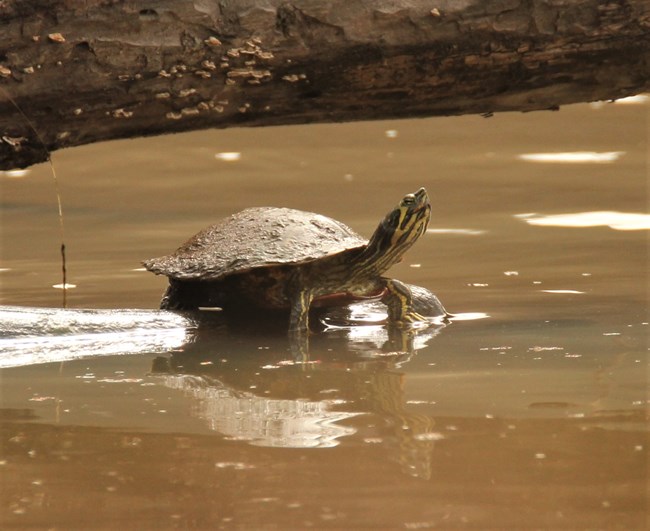|
Ninety-Six has many habitats that support reptiles. These include but are not limited to shallow wetlands, floodplain areas, streams, and river swamps. There are many different kinds of snakes, lizards, and turtles that you may see here at the park. It is important to note that you should NOT touch the reptiles you see because some may be venomous, and it is better to just look rather than touch. Here are a few “friendly” reptiles you may see on your next visit! 
NPS/VIP Wilson Black rat snake (Pantherophis obsoletus)Diet: Mice, rats, moles, chipmunks are the main diet of the Black Rat Snake but they are also known to feed on small lizards, frogs and bird eggs. Lifespan: 10-15 years in the wild. Habitat: Fields, woodlands, farmlands, and around suburban communities. Where to find: These snakes can be found in tall grasses and sometimes on trees. Generally, they stay hidden but are also known to be seen sunning on rocks and paved trails. Season of Sight: Spring and Summer. Breeding season: Late April to early June. Fun Fact: One of the longest snakes native to North America, reaching lengths of 8 feet. 
NPS/Stewart Eastern fence lizard (Sceloporus undulatus)Diet: Beetles, ants, moths, grasshoppers, stink bugs, spiders, and other invertebrates. Lifespan: Approximately 5 years. The average lifespan is unknown. Habitat: Woodlands, grasslands, and shrublands. Where to find: Usually found on trees around the park. Season of Sight: Late spring to summer. Breeding season: April to August. Fun Fact: Male Eastern Fence Lizards have blue scales on their underbelly and neck which they will flash at rival males for claim over their territory and females. 
NPS/VIP Wilson Yellow-bellied slider (Trachemys scripta scripta)Diet: Mostly plants found in the ponds they live in but will also eat fish, tadpoles, spider, snails, bugs, and crayfish. Lifespan: 40-50 years. Habitat: Carolina bays, sloughs, sinkholes, oxbow lakes, swamps, rivers, lakes, and ponds. Where to find: Can be found on rocks or logs in or around ponds can also be found in ponds. Season of Sight: Spring and Summer. Breeding season: Spring is considered the formal breeding season, but courtship has been observed by males in the fall and winter. Fun Fact: These turtles communicate through touch and vibration. |
Last updated: April 29, 2023
